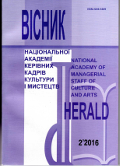SPANISH AND UKRAINIAN ETHNOSPECIFIC PHRASEOLOGICAL UNITS IN THE PRESS
DOI:
https://doi.org/10.32461/2226-3209.2.2016.138505Keywords:
a phraseological unit, an ethno-specific component, background knowledge, an image model, phra-seological cognateAbstract
The research studies Spanish and Ukrainian ethno-specific phraseological units in the press. The author defines their informational and communicative peculiarities and figurative possibilities of using them in periodical press. Peculiarities of Methodology. In the furtherance of the goal, the author uses some general scientific and special linguistic research methods, in particular: synthesis, analysis, ethnic-national, linguo-genetic, descriptive, comparative, complex-procedural. The use of the complex methods enables to consider the ethno-specific phraseological units in the pragmatics of a jour-nalistic text: they contribute to the creation of a specific newspaper imagery and expressivity by inclusion of argumenta-tion and social orientation into the process. The conclusion is that linguistic meaning of phraseological units as carriers of ethno-specific meaning of the text is determined by the degree of their idiomaticity. In the process of intercultural communication, phraseological units with a cultural component are a source of additional information. It makes the pro-cess of interactive relationship more complicated because information contained in these units is not always understand-able for representatives of other cultures. At the same time, the expansion of intercultural communication sphere contrib-utes to internationalization of phraseological units and, therefore to convergence and a dialogue of cultures.
Downloads
Published
Issue
Section
License
Authors who publish with this journal agree to the following terms:
1. Authors retain copyright and grant the journal right of first publication with the work simultaneously licensed under a Creative Commons Attribution License that allows others to share the work with an acknowledgement of the work's authorship and initial publication in this journal.
2. Authors are able to enter into separate, additional contractual arrangements for the non-exclusive distribution of the journal's published version of the work (e.g., post it to an institutional repository or publish it in a book), with an acknowledgement of its initial publication in this journal.
3. Authors are permitted and encouraged to post their work online (e.g., in institutional repositories or on their website) prior to and during the submission process, as it can lead to productive exchanges, as well as earlier and greater citation of published work (See The Effect of Open Access).


